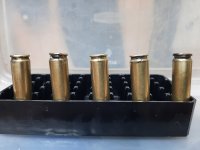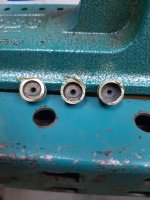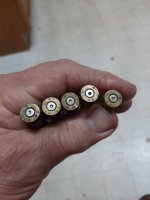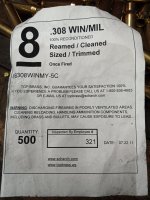So with everything that has been posted here is my best guess at what might have happened.
Case was converted from once fired .223 case. Here is a list of case head stamps that are
not suitable for conversion to 300 BO:
"
Thick neck wall, bad without neck turning:
ATI - 0.015" [Note 3]
CBC - 0.014/0.015"
CJ6 - 0.015"
DNL - 0.016"
FNM - 0.016" [Note 3]
FRONTIER - 0.015"
GECO - 0.015/0.016"
Hot Shot - 0.014" [Note 3]
HRTRS ( Herters?) - 0.017"
ICC - Reported as bad
IK03 - 0.015" [Note 4]
IMI - 0.015" [Note 4]
KFA .223 REM - 0.015"-0.019"
MKE13 - Anecdotally reported as troublesome
MPA - 0.015"
NPA - [Note 3]
PMC (old headstamp) - 0.015"
PMP - 0.015"
PPU - 0.014/0.015" [Note 3]
RORG - 0.015"
RWS - 0.014-0.015"
S&B - 0.015/0.017"
Wolf Brass .223 - 0.014"
General notes:
There's no consistent difference between "5.56" and "223" when it comes to brass."
Now minimum chamber is 0.335" and maximum case neck is 0.334". That means zero clearance in chamber would be 0.355" minus 0.308 equals 0.027" or 0.135" case neck thickness, anything greater would be a interference press fit.
Even if you can't determine the case headstamp you can measure the neck thickness of the piece of brass pulled from the chamber. That number will tell you if there was any neck clearance for the loaded round or the round was pressed into the chamber and locking the bullet in the case. If it was locked into the case that would create excess chamber pressure above the max 55,000 psi SAAMI number.
The only place the case is not surrounded is between the barrel and bolt. Excess pressure would cause case separation. Bolt would be driven back against the inside barrel extension and deform the bolt and barrel extension as the pressure drives the carrier rearward. During this the bolt is fractured, the carrier is split and resulting damage to the receivers and rounds in the magazine.
A simple oversight of not checking the neck wall thickness could have been the cause of this incident.





